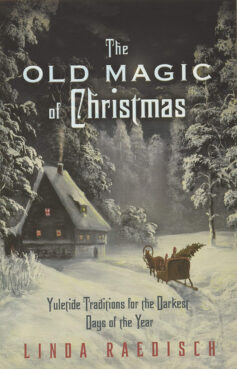(RNS) — Reading the encyclopedia and watching public television as a kid, Linda Raedisch caught glimpses of “another Christmas” — one filled with ghosts and witches, where elves weren’t friendly toymakers tinkering in Santa’s workshop and the temperature wasn’t the only thing that was chilling.
“I like the scary and the sacred coming together at this dark time of year,” she said.
She wanted to know more, not only about the most frightening folklore of Christmases past, but also about the pagan and Christian origins of the traditions many still observe in the present.
That’s what led Raedisch, who writes and lectures on all things arcane, to write the book “The Old Magic of Christmas: Yuletide Traditions for the Darkest Days of the Year.”
Several books and nearly a decade later, she said, “The Old Magic of Christmas” is “still the child of mine that everybody loves.” She still receives Christmas cards from readers with the holiday greetings scratched out and “Happy Solstice!” inscribed in their place, and learns of new and different things readers are finding in the book than she had in mind when she wrote it.

“The Old Magic of Christmas: Yuletide Traditions for the Darkest Days of the Year” by Linda Raedisch. Courtesy image
Christmas always has been a bit spooky, Raedisch said. In the biblical account of the Christmas story, she pointed out, angels share the news that Jesus has been born with the greeting, “Fear not!” which suggests a frightening appearance.
And ghost stories — best known from Charles Dickens’ classic story “A Christmas Carol” and referenced in that one line in the song “It’s the Most Wonderful Time of the Year” — were for many years a popular way to pass the time around the fire during long, cold winter nights.
“I think that we long for the sacred, but it frightens us also, and maybe Christmas is a way — just like Halloween is a way — of confronting the bad, scary stuff and making light of it,” she said.
It’s not just the scary and the sacred that mix and mingle during the Yuletide, Raedisch said, but also Christian and pagan traditions. While some debate whether Christmas trees and Santa Lucia’s crown of candles were introduced by Christians celebrating Christmas and various saints’ feasts or if they come from pagans celebrating Yule and the winter solstice, the author said she doesn’t like to single out traditions as belonging to one religion or another.
“I think it’s richer when it’s all all together,” she said.
Many of her readers are well-read witches and pagans, she said, but she hopes the book can bring everybody together for the holidays, including Christians and those, like her, who lean toward secular humanism and whose spiritual practices are “reading and writing.” Pagans and Christians alike can rediscover the “reason for the season” in the old stories and deepen their own beliefs.
Here are a few of the scary ghost stories of Christmases long, long ago that Raedisch conjures in “The Old Magic of Christmas.”

